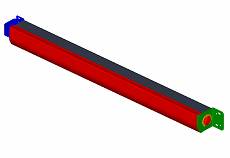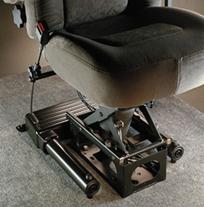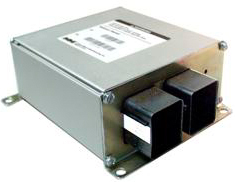ITS - INFLATABLE TUBULAR STRUCTURE
The ITS system consists of a tubular side airbag designed to protect the occupant's head during a rollover. The airbag is attached to the vehicle at each end. Before deployment it is normally stowed above the side window. As the diameter of the airbag increases during inflation its length decreases. The deployed airbag generates tension between attachment points and is positioned to protect the specified range of occupants.
While stowed in the vehicle, the airbag is contained inside a trim cover. The trim cover opens and releases the airbag during deployment. The trim components are elastomeric extrusions that are attached to the vehicle interior. The system uses a stored-gas inflator to generate inflation gases. This inflator is connected to the airbag by a length of flexible hose.
IHC - INFLATABLE HEAD CUSHION
 The Inflatable Head Cushion is a state-of-the-art, pyrotechnic device offered as part of the C.A.P.™ system. Designed to be compact and modular, the IHC assembly can be installed at any seating position within a vehicle.
The Inflatable Head Cushion is a state-of-the-art, pyrotechnic device offered as part of the C.A.P.™ system. Designed to be compact and modular, the IHC assembly can be installed at any seating position within a vehicle.
The Inflatable Head Cushion protects the head and neck during a rollover event. It uses a gas-generating device (a.k.a. inflator) to achieve its inflated state within specified design parameters.
The IHC is designed to provide adequate head coverage for a range of occupants from 5 th percentile female to the 95 th percentile male. The cushion typically deploys and inflates in less than 50 milliseconds after the firing current is applied. In its deployed state, the cushion covers approximately 0.17 sq. meters (1.8 sq. ft.), and occupies a volume of approximately 20 liters (1220 cubic inches). Due to its unique construction and specialized coating, the airbag is capable of maintaining adequate pressure for a minimum of 5 seconds.
IBP - INTEGRATED BUCKLE PRETENSIONER
The Buckle Pretensioner is a pretensioning system using a micro gas generator to pretension the occupant’s belt during a roll over. The Buckle Pretensioner is mounted in all static seating positions. The pretensioner deploys upon receiving a signal from the rollover sensor. The pretensioner retracts the cable and buckle removing slack from the belt. The buckle pretensioner is only effective when you wear your seatbelt.
S4S - SUSPENSION SEAT SAFETY SYSTEM
 The S4S is a seat and occupant pretensioning system using a stored gas powered actuator to pretension the occupant’s belt and pull down the suspension seat during a roll over. It is designed to safely move an occupant ranging from a 5 th percentile female to a 95 th percentile male, from an elevated position relative to normal driving conditions, to the seat’s lowest position while maintaining a tightened belt. This action will occur in 100 to 180 milliseconds.
The S4S is a seat and occupant pretensioning system using a stored gas powered actuator to pretension the occupant’s belt and pull down the suspension seat during a roll over. It is designed to safely move an occupant ranging from a 5 th percentile female to a 95 th percentile male, from an elevated position relative to normal driving conditions, to the seat’s lowest position while maintaining a tightened belt. This action will occur in 100 to 180 milliseconds.
For the S4S mechanism to provide adequate impulse to move the mass of a 95 th percentile occupant in the prescribed time, it is necessary that the device produce a substantial force. The surface to which the actuator is mounted must react these forces.
ROLLOVER SENSOR
 The C.A.P. ® System Roll Sensor is an electronic module used to deploy advanced occupant restraint systems in the event of a vehicle roll over. In response to a roll event, the Roll Sensor activates safety devices in a pre-programmed sequence. An event recorder tracks onboard data before and after a roll event. Real time diagnostics monitor all critical subsystems. The roll sensor is designed to meet the environmental and electrical conditions of the apparatus.
The C.A.P. ® System Roll Sensor is an electronic module used to deploy advanced occupant restraint systems in the event of a vehicle roll over. In response to a roll event, the Roll Sensor activates safety devices in a pre-programmed sequence. An event recorder tracks onboard data before and after a roll event. Real time diagnostics monitor all critical subsystems. The roll sensor is designed to meet the environmental and electrical conditions of the apparatus.
The roll sensor incorporates a power reserve for one second in case of power loss during a roll event. A 10 second roll event data recorder captures and records the angle and rate of roll eight seconds before and two seconds after a roll event and records fault status and switch status at the time of the roll. The sensor shall be capable of SAE J1708/J1587 diagnostics using proprietary communication protocol for roll event reconstruction data and is SAE J1939 capable. In addition the roll sensor includes five non-firing outputs rated for 250 mA.
These outputs drive lamps, relays, or signal data logging devices. One output is reserved for the dash warning lamp, which illuminates for 10 seconds on power-up to indicate proper operation. Faults and roll events shall illuminate the lamp continuously. There are four switch closure sensing inputs to record switch status in the event data recorder.